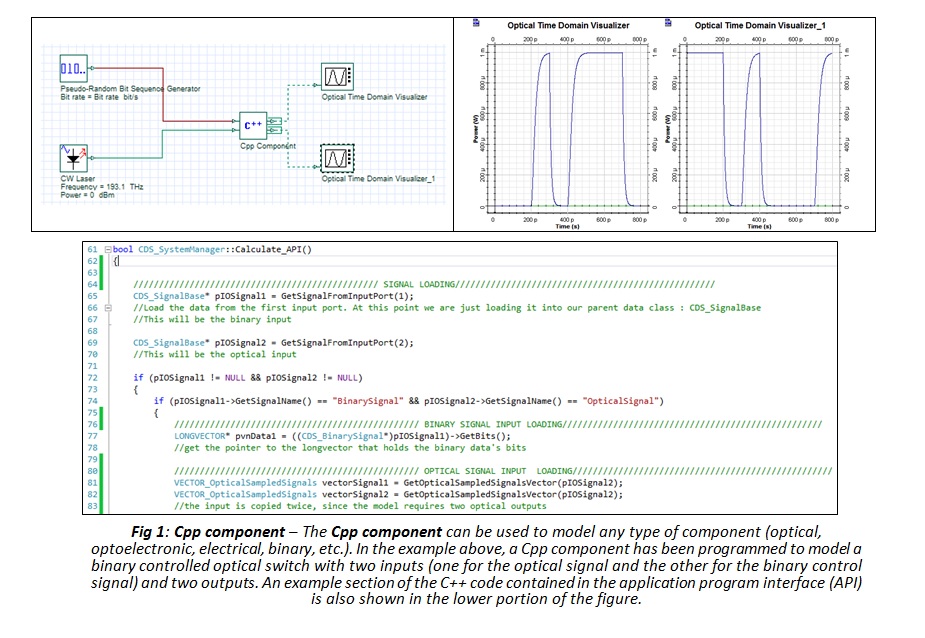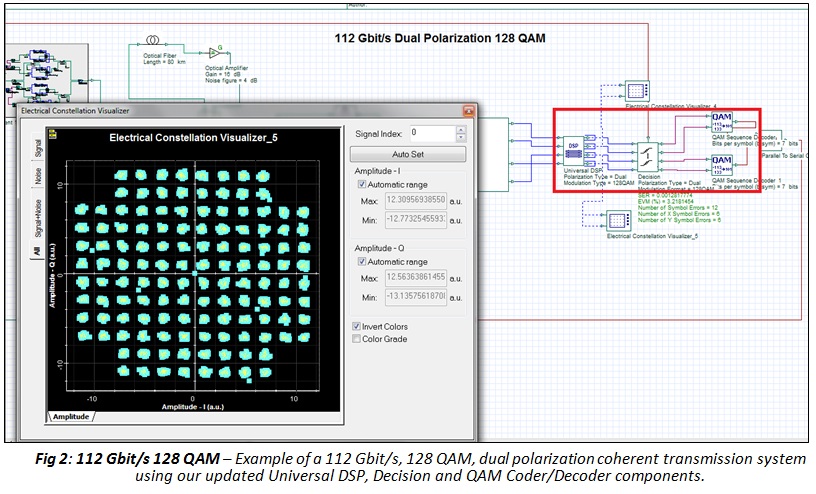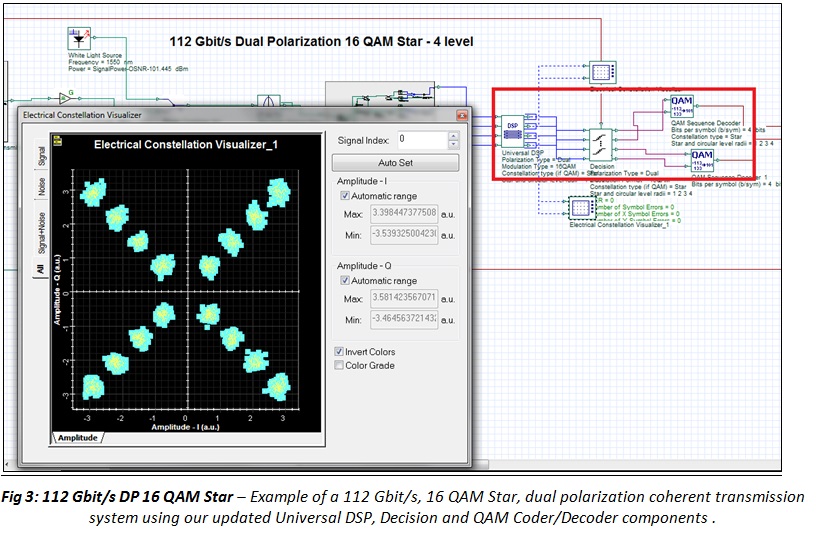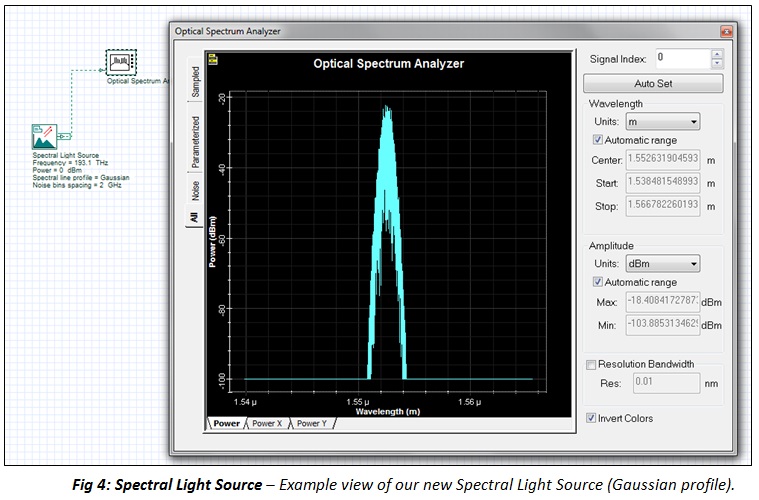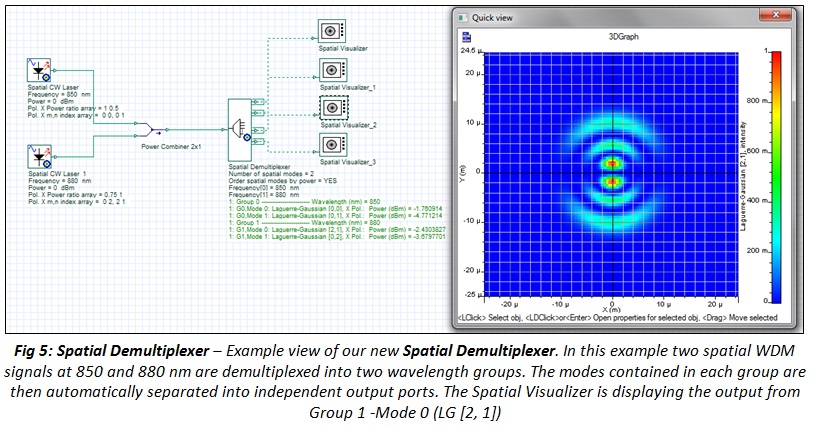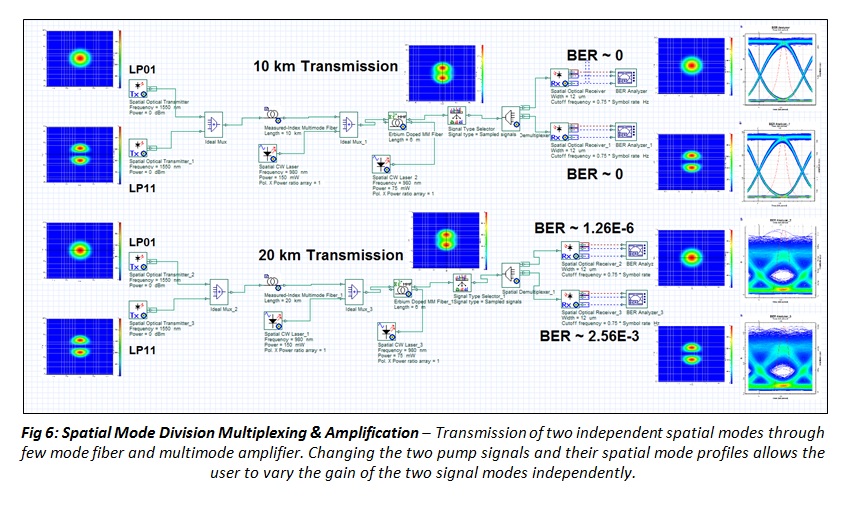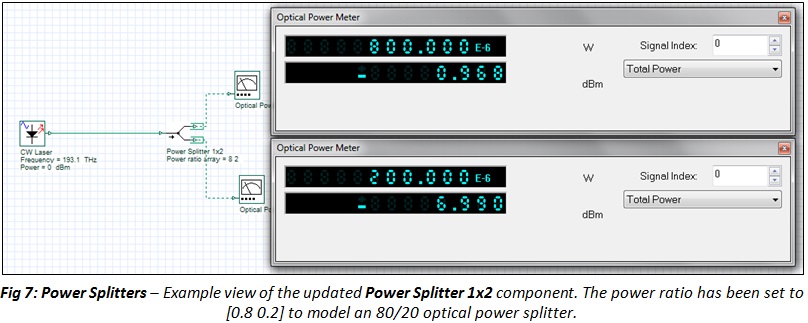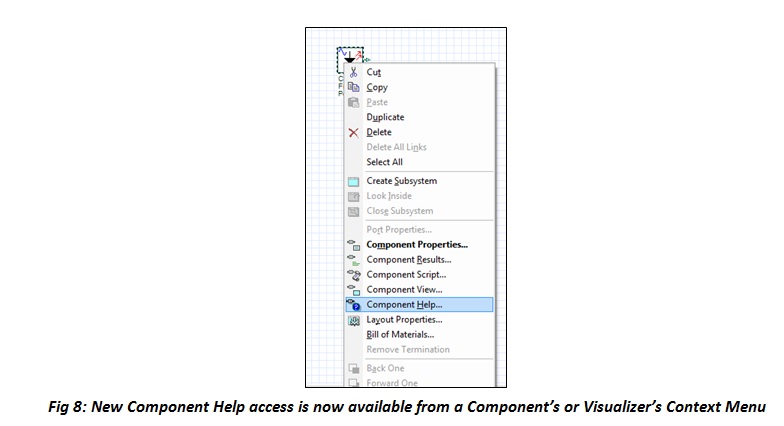OptiSystem 14 includes several enhancements including a new C++ co-simulation component, updates to our multimode component portfolio (to better support the analysis of spatial mode multiplexed systems), the addition of star and circular QAM constellations for coherent transmission systems, and improvements to our transmitter and receiver component portfolios.
Key New Features
Introduction of a new Cpp component and Cpp CoSimulation Visualizer to allow users to import or build their own customized C++ algorithms/components and directly co-simulate their customized models (using dynamic link libraries) with any other OptiSystem component.
Universal DSP, Decision, QAM Sequence Generator and QAM Sequence Decoder components have been updated to support a broader range of modulation formats, including star and circular QAM constellation formats as well as 32-QAM, 128-QAM, and 256-QAM constellations.
Enhancements have been made to the Multimode components library including the introduction of a new Spatial Demultiplexer component, improvements to the Erbium Doped MM Fiber, Ytterbium Doped MM Fiber, Measured-Index Multimode Fiber and Parabolic-Index Multimode Fiber amplifier and fiber models (for modelling spatial multiplexed systems and concatenated fibers) and the integration of LP mode generators into our Spatial Transmitter components.
Components within the Transmitters and Receivers libraries have been improved including the introduction of a new Spectral Light Source component, improvements to the noise models in the APD and PIN components, the addition of thermal noise models to our Analog to Digital and Digital to Analog components and the addition of user-defined PAM amplitude maps to our PAM Coder and Decoder components.
Updates to our Measured Filter, Measured Optical Filter, Lightwave Analyzer, View Signal Visualizer and Power Splitters; and the introduction of a new Diffuse Channel component for the modeling of indoor optical wireless systems.
New library components and enhancements
Co-simulation capabilities: Cpp, Cpp CoSimulation Visualizer
We are pleased to announce the launch of our new Cpp component in OptiSystem 14. Designed for users who wish to import or build their own customized C++ algorithms/components, the Cpp component will allow for the direct co-simulation of customized models (using dynamic link libraries) with any other OptiSystem component. It includes an open signal architecture interface to allow users to input and/or output any of OptiSystem’s signal types and complex waveform data arrays.
In addition to the Cpp component, we have launched a new Visualizer, the Cpp CoSimulation Visualizer. The new Cpp CoSimulation Visualizer’s primary function is to duplicate all the signals that are designed to enter the Cpp component thus allowing for signal files to be loaded into the component design project (without OptiSystem running) when running in debug mode.
If you require assistance in setting up a design with the C++ component please contact us at support@optiwave.com.
Transmitters and receiver design: Universal DSP, Decision, QAM coding update, PAM coding update, ADC and DAC updates, TIA update, APD update, Spectral Light Source, LED update
The Universal DSP and Decision components have been updated to support a broader range of modulation formats, including:
- – BPSK, QPSK, 8PSK, 16PSK
- – 8QAM, 16QAM, 32QAM, 64QAM, 128QAM, 256QAM
In addition, for QAM modulation formats; star and circular constellation formats are now supported.
The QAM Sequence Generator and QAM Sequence Decoder components now support the definition of square, star, and circular constellation formats (with differential or gray coding).
All components which create or decode PAM sequences (PAM Sequence Generator, PAM Pulse Generator, Electrical PAM Modulator, and PAM Sequence Decoder) now include the option to import or update user-defined PAM amplitude maps (using the MxN parameters array feature).
A new Spectral Light Source component has been added to the Transmitters/Optical Sources library. Lorentzian, Gaussian or file-based (user-defined) spectral profiles can be created to model various ambient light sources or LEDs.
The LED component has been updated to include the ability to import a user-defined spectral profile (measured optical filter feature). Also the output power setting feature now includes the ability to define the slope efficiency.
The APD component has been updated and includes the following new features:
- – The thermal noise model has been updated to include the definition of thermal noise based on temperature and load resistance.
- – New results have been added for shot and thermal noise currents.
- – A new parameter has been added to allow for the definition of noise bandwidth based on the Effective noise bandwidth parameter.
The Transimpedance amplifier component now includes the ability to import measured electrical filter data (frequency transfer function model).
A new thermal noise model has been added to the Analog to Digital and Digital to Analog components, including new calculation results for thermal noise currents and quantization noise.
Multimode system design: Spatial Demultiplexer, Erbium Doped MM Fiber, Ytterbium Doped MM Fiber, Measured-Index Multimode Fiber, Parabolic-Index Multimode Fiber, Spatial Transmitters
A new Spatial Demultiplexer component has been added to the Multimode Library. In addition to separating WDM channels, the Spatial Demultiplexer allows for the separation of spatial modes contained within each WDM channel (each with an independent output port).
The Erbium Doped MM Fiber and Ytterbium Doped MM Fiber amplifier models have been improved to allow for the more realistic and efficient modeling of space division multiplexing systems. Updates include:
- – The specification of the refractive index profile based on parabolic index, alpha, step index or file-based specification.
- – Parameters associated with cladding pumping have been removed. Instead the input signal to the fiber can be coupled to a cladding pump by using the Donut Transverse Mode Generator component.
- – The numerical algorithm (overlap integrals) has been improved and now applies a mode dependent gain. Please note that the computation time may take longer compared to the previous version of these components.
- – Parameters associated with spatial properties of the pumps have been removed. Instead the pumps can now be set up with spatial mode properties.
The Measured-Index Multimode Fiber and Parabolic-Index Multimode Fiber models have been improved to support the modeling of spatial multiplexing systems and concatenated fibers. Updates include:
- – A new method for incorporating optical phase changes due to mode-dependent path length differences.
- – Improved management of multiple input spatial modes.
- – Improved tracking and preservation of phase data between concatenated fibers.
- – An improved Fibers report feature including customized ordering of spatial mode results based on power, group index or LP index.
The Spatial Transmitters components (Spatial Optical Transmitter, Spatial CW Laser, Spatial single mode laser, Spatial LED, Spatial VCSEL, Spatial Optical Gaussian Pulse Generator, Spatial Optical Impulse Generator and Spatial Optical Sech Pulse Generator), further to the generation of LG and HG modes, have been updated to include the definition and generation of fiber LP modes (for convenience and testing purposes).
Other product enhancements
Measured filters
The Measured Filter and Measured Optical Filter components have been updated with additional graphs to display amplitude/power and phase. Also a new feature has been added to allow for the automatic reloading of the transfer function data file every time a simulation is initiated (such as simulations that require multiple iterations).
Visualizers and Test Sets
The Lightwave Analyzer has been updated to include graphs for Slope Responsivity and Responsivity (DC).
The View Signal Visualizer now includes the ability to view complex data in either Real-Imag or Mag-Phase formats
Optical Wireless
The new Diffuse Channel component allows for the modeling of indoor optical wireless systems (Lambertian source model).
Passives
A new power ratio array feature has been added to the unidirectional optical power splitter components (to allow for the definition of customized splitting ratios for all output ports). Components include: Power Splitter 1×2, Power Splitter 1×4, Power Splitter 1×8 and Power Splitter 1xN
Documentation and help feature updates
A new Global Parameters Reference Guide has been included with OptiSystem 14. This new guide provides information on the global parameters features including tips on how to best set up your simulation for optimum results. To access this guide select the “Help” button within the Layout Parameters dialog box.
A new link is now available for users to access the Component Help section directly from a Component’s or Visualizer’s Context Menu.
New URL links have been added to the Help Menu (to provide rapid access to the OptiSystem Home Page and OptiSystem Forums).



